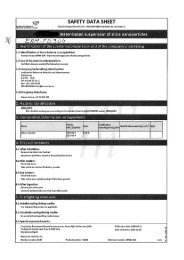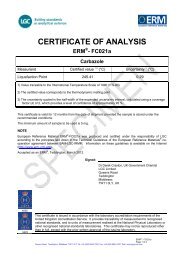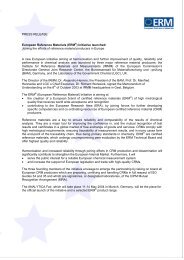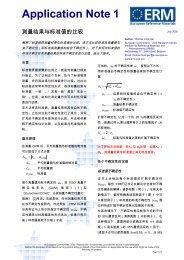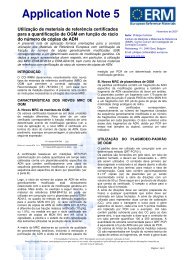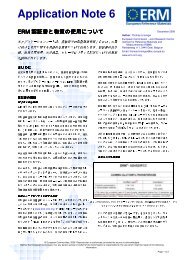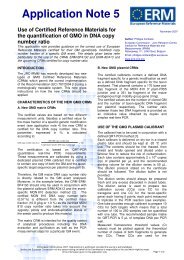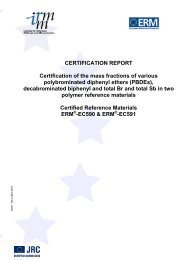Certified Reference Materials ERM®-BF418 - European Reference ...
Certified Reference Materials ERM®-BF418 - European Reference ...
Certified Reference Materials ERM®-BF418 - European Reference ...
Create successful ePaper yourself
Turn your PDF publications into a flip-book with our unique Google optimized e-Paper software.
Report EUR 21689 EN<br />
CERTIFICATION REPORT<br />
The Certification of <strong>Reference</strong> <strong>Materials</strong> of<br />
Dry-Mixed Maize Powder with different Mass<br />
Fractions of 1507 Maize<br />
<strong>Certified</strong> <strong>Reference</strong> <strong>Materials</strong> ERM ® -<strong>BF418</strong><br />
(ERM ® -<strong>BF418</strong>a / ERM ® -<strong>BF418</strong>b / ERM ® -<strong>BF418</strong>c /<br />
ERM ® -<strong>BF418</strong>d)
The mission of IRMM is to promote a common and reliable <strong>European</strong> measurement system in support of EU policies.<br />
<strong>European</strong> Commission<br />
Directorate-General Joint Research Centre<br />
Institute for <strong>Reference</strong> <strong>Materials</strong> and Measurements<br />
Contact information<br />
Hendrik Emons<br />
<strong>European</strong> Commission<br />
Directorate-General Joint Research Centre<br />
Institute for <strong>Reference</strong> <strong>Materials</strong> and Measurements<br />
Retieseweg 111<br />
B-2440 Geel • Belgium<br />
Email: hendrik.emons@cec.eu.int<br />
Tel.: +32 (0)14 571 722<br />
Fax: +32 (0)14 571 548<br />
http://www.erm-crm.org<br />
Legal Notice<br />
Neither the <strong>European</strong> Commission nor any person acting on behalf of the Commission is responsible for the<br />
use which might be made of the following information.<br />
A great deal of additional information on the <strong>European</strong> Union is available on the Internet.<br />
It can be accessed through the Europa server<br />
http://europa.eu.int<br />
EUR Report 21689 EN<br />
Luxembourg: Office for Official Publications of the <strong>European</strong> Communities<br />
ISBN 92-894-9748-3<br />
© <strong>European</strong> Communities, 2005<br />
Reproduction is authorised provided the source is acknowledged<br />
Printed in Belgium
Report EUR 21689 EN<br />
CERTIFICATION REPORT<br />
The Certification of <strong>Reference</strong> <strong>Materials</strong> of<br />
Dry-Mixed Maize Powder with different Mass Fractions<br />
of 1507 Maize<br />
<strong>Certified</strong> <strong>Reference</strong> <strong>Materials</strong> ERM ® -<strong>BF418</strong><br />
S. Trapmann, P. Conneely, M. Contreras, P. Corbisier, D. Gancberg,<br />
E. Hannes, S. Gioria, A. Muñoz-Pineiro, M. Van Nyen, H. Schimmel,<br />
S. Szilagy, H. Emons<br />
<strong>European</strong> Commission, Directorate General Joint Research Centre,<br />
Institute for <strong>Reference</strong> <strong>Materials</strong> and Measurements (IRMM), Geel (BE)
SUMMARY<br />
This report describes the preparation and certification of dry-mixed maize powder<br />
<strong>Certified</strong> <strong>Reference</strong> <strong>Materials</strong> (CRMs) with different mass fractions of genetically<br />
modified (GM) 1507 maize powder (CRMs ERM-<strong>BF418</strong>a, ERM-<strong>BF418</strong>b, ERM-<br />
<strong>BF418</strong>c and ERM-<strong>BF418</strong>d). The CRMs were processed in 2004 and certified in<br />
2005 by the <strong>European</strong> Commission, Directorate General Joint Research Centre, the<br />
Institute for <strong>Reference</strong> <strong>Materials</strong> and Measurements (IRMM) in Geel, Belgium.<br />
Seeds of non-modified maize and 1507 maize, both supplied by Pioneer Hi-Bred<br />
International (Johnston, IA, USA), were rinsed with demineralised water, drained<br />
and dried at 30 °C in order to minimise dust contamination from other crops. After a<br />
two step grinding process, transforming the seeds into a non-modified maize powder<br />
and a 1507 GM maize powder, the CRMs were gravimetrically prepared and<br />
homogenised by turbula- and dry-mixing.<br />
The CRMs are intended for the quality control and calibration of methods for the<br />
detection and quantification of genetically modified food and feed. The 1507 mass<br />
fractions of ERM-<strong>BF418</strong> were verified with the help of a DNA-based detection<br />
method. The CRMs are available in glass bottles containing 1 g of maize powder<br />
closed under argon atmosphere.<br />
The four CRMs belonging to the set ERM-<strong>BF418</strong> were certified to contain the<br />
following 1507 mass fractions:<br />
CRM <strong>Certified</strong> value<br />
1507 mass fraction 1)<br />
[g/kg]<br />
1<br />
Uncertainty 2)<br />
[g/kg]<br />
ERM-<strong>BF418</strong>a < 0.5 not applicable<br />
ERM-<strong>BF418</strong>b 1.0 -0.2; +0.6<br />
ERM-<strong>BF418</strong>c 9.9 -0.6; +0.8<br />
ERM-<strong>BF418</strong>d 98.6 -1.7; +2.0<br />
1) The certified value is based on the mass fraction of dried non-genetically modified powder and<br />
dried genetically modified powder mixed and corrected for the water content. The certified value is<br />
traceable to the SI.<br />
2) The certified uncertainty is the expanded uncertainty estimated in accordance with the Guide to the<br />
Expression of Uncertainty in Measurement (GUM) with a coverage factor k = 2, corresponding to a<br />
level of confidence of about 95 %.<br />
The minimum sample intake recommended for analysis is 100 mg.
GLOSSARY<br />
x average<br />
CRM <strong>Certified</strong> <strong>Reference</strong> Material<br />
CTAB cetyltrimethylammonium bromide<br />
Ct-value number of PCR cycles to pass a set threshold<br />
CV coefficient of variation<br />
DNA deoxyribonucleic acid<br />
dsDNA double-stranded DNA<br />
FAM 6-FAM fluorescent dye<br />
gDNA genomic DNA<br />
GM genetically modified<br />
GMO genetically modified organism<br />
HMGa high mobility group protein A gene from Zea mays<br />
IRMM Institute for <strong>Reference</strong> <strong>Materials</strong> and Measurements<br />
k coverage factor<br />
KFT Karl Fischer titration<br />
LOD limit of detection<br />
LOQ limit of quantification<br />
MON 863 GM maize event MON 863<br />
n number of samples analysed<br />
NAA neutron activation analysis<br />
PCR polymerase chain reaction<br />
PSA particle size analysis<br />
R 2<br />
coefficient of correlation<br />
rt-PCR real-time PCR<br />
s standard deviation<br />
SI International System of Units<br />
U expanded uncertainty<br />
u standard uncertainty<br />
UV ultra-violet<br />
1507 GM maize event 1507<br />
2
Table of contents<br />
1 INTRODUCTION.................................................................................................................5<br />
2 CRM PREPARATION........................................................................................................5<br />
2.1 CHARACTERISATION OF THE BASE MATERIALS ............................................................................................ 5<br />
2.2 PROCESSING OF THE GROUND BASE MATERIALS........................................................................................... 8<br />
2.3 GRAVIMETRICAL PREPARATION OF THE GM MIXTURES ............................................................................... 9<br />
2.4 BOTTLING.................................................................................................................................................... 9<br />
2.5 PROCESSING CONTROL................................................................................................................................. 9<br />
3 HOMOGENEITY ...............................................................................................................11<br />
3.1 HOMOGENEITY STUDY AND HOMOGENEITY ASSESSMENT .......................................................................... 11<br />
3.2 MINIMUM SAMPLE INTAKE FOR ANALYSIS ................................................................................................. 12<br />
4 STABILITY.........................................................................................................................12<br />
4.1 SHORT-TERM STABILITY ............................................................................................................................ 12<br />
4.2 LONG-TERM STABILITY.............................................................................................................................. 13<br />
5 CERTIFIED MASS FRACTIONS AND UNCERTAINTY BUDGETS.......................13<br />
5.1 TRACEABILITY........................................................................................................................................... 13<br />
5.2 CERTIFIED VALUE ...................................................................................................................................... 14<br />
5.3 UNCERTAINTY BUDGET.............................................................................................................................. 14<br />
6 VERIFICATION OF 1507 MAIZE MIXTURES.............................................................15<br />
REFERENCES AND ACKNOWLEDGEMENTS ............................................................17<br />
REFERENCES.................................................................................................................................................... 17<br />
ACKNOWLEDGEMENTS .................................................................................................................................... 18<br />
ANNEX...................................................................................................................................19<br />
3
1 Introduction<br />
Legislation in the <strong>European</strong> Union demands the labelling of food and feed products<br />
consisting of or containing more than 0.9 % genetically modified organisms (GMOs),<br />
provided the GMO has been placed on the market in accordance with Community<br />
legislation [1]. This enforces the necessity on the one hand to develop and validate<br />
reliable quantitative detection methods and on the other hand to develop and<br />
produce reference materials to calibrate and control the correct application of<br />
detection methods. Therefore, mixtures of genetically modified (GM) and non-GM<br />
powders have been prepared and certified as <strong>Certified</strong> <strong>Reference</strong> <strong>Materials</strong> (CRMs).<br />
A set of CRMs of maize powder with different mass fractions of dried GM maize<br />
powder of the transformation event 1507 (< 0.5, 1.0, 9.9, 98.6 g/kg maize) was<br />
processed and certified by IRMM. The four CRMs (ERM-<strong>BF418</strong>a, ERM-<strong>BF418</strong>b,<br />
ERM-<strong>BF418</strong>c and ERM-<strong>BF418</strong>d) are available from IRMM and its authorised<br />
distributors [2]. According to <strong>European</strong> Commission regulation (EC) No 65/2004 [3]<br />
the event 1507 maize corresponds to the unique identifier DAS-Ø15Ø7-1.<br />
ERM-<strong>BF418</strong> has been produced by means of dry-mixing techniques in order to<br />
minimise DNA and protein degradation during the processing.<br />
2 CRM preparation<br />
2.1 Characterisation of the base materials<br />
For the preparation of the CRMs, Pioneer Hi-Bred International (Johnston, IA, USA)<br />
supplied seeds of non-modified maize and GM 1507 maize to the IRMM. 50 kg of<br />
non-modified maize and 10 kg of 1507 maize were used for the processing of ERM-<br />
<strong>BF418</strong>.<br />
The purity and genetic composition of these batches were verified at IRMM with the<br />
help of genomic DNA (gDNA) extracted from leaves of seedlings. Seeds of each<br />
batch (n = 52) were randomly chosen and allowed to germinate. Genomic DNA was<br />
extracted from pieces of the young leaves with a mass of approximately 110 mg<br />
using the DNeasy® Plant Mini kit (Qiagen, Hilden, DE). The extracted DNA was<br />
analysed on a 1 % agarose gel (10 g/L) and quantified using the PicoGreen®<br />
dsDNA quantification kit (Molecular Probes Europe, Leiden, NL). The average DNA<br />
yield ± s per 100 mg wet tissue was 5.1 ± 0.9 µg for the GM tissue and 4.8 ± 1.3 µg<br />
for the non-GM tissue.<br />
Detection by rt-PCR was performed at IRMM following the TaqMan® Universal PCR<br />
Master Mix protocol (Applied Biosystems, Foster City, CA, USA). Primer pairs<br />
specific for the event 1507 and the HMGa endogenous maize gene have been used<br />
together with TaqMan probes labelled with FAM. The threshold cycle values (Ctvalue)<br />
determined for the 52 GM plants were compared to a calibration curve<br />
obtained from dilution series of gDNA extracted from pure 1507 powder. All GMO<br />
plants tested positive for 1507 and the measured average mass fraction ± s of GM<br />
1507 maize, estimated via the transgenic copy number measured relative to the<br />
5
copy number of an endogenous gene, was 722 ± 97 g/kg (n = 52) 1) . All non-GMO<br />
plants were tested in the same way and appeared negative for the event 1507<br />
(Table 1).<br />
Table 1: Purity test and genetic composition of the GM and non-GM seed<br />
batches used for the production of ERM-<strong>BF418</strong><br />
Batch<br />
PCR method performed<br />
and primers used 1)<br />
Number of<br />
plants<br />
tested<br />
Number of<br />
1507<br />
positives<br />
Number of<br />
1507<br />
negatives<br />
Non-GM event-specific real-time PCR 52 0 52<br />
GM event-specific real-time PCR 52 52 0<br />
1) Primer sequences of the event-specific 1507 method have been provided by Pioneer [4] and can be<br />
found in the Annex.<br />
Additionally the purity of the ground non-GM base material was tested at IRMM. The<br />
analysis of randomly selected seeds and subsequent analysis of the powder (five<br />
DNA extractions from 100 mg powder each) indicated that no GM contamination<br />
was detected in the non-GM lot, i.e. the values obtained were all below the detection<br />
limit (LOD) of the rt-PCR method applied (Table 2).<br />
Within the frame of an in-house validation of the method the LOD and the limit of<br />
quantification (LOQ) were assessed. The LOD was calculated as (3.3 · s)/b, with s<br />
representing the standard deviation of a defined GM mass fraction and b the slope<br />
of the calibration curve. This defined GM mass fraction was taken as the lowest GM<br />
mass fraction for which the amplification efficiency was optimal. The efficiency of the<br />
amplification was determined based on the slope of the regression line between the<br />
GM mass fraction and the Ct-values, which should not be lower than the theoretical<br />
value of 3.322. The LOQ was calculated as (10 · s)/b.<br />
LOD and LOQ have been established by dilution of DNA extracted from pure GM<br />
1507 powder in nuclease free water and were found to be 0.4 g/kg and 1.1 g/kg,<br />
respectively.<br />
1)<br />
Due to the calibration with powders produced from seeds (and the genetic composition of the various tissue<br />
types), the rt-PCR results obtained for the gDNA extracted from plants can deviate considerably from pure GM<br />
powder.<br />
6
Table 2: Quantification of GM 1507 contamination in the non-GM base material<br />
by event-specific rt-PCR using 100 mg sample intakes<br />
Non-GM base material<br />
Number of DNA<br />
extractions 2)<br />
7<br />
Mass fraction<br />
GM contamination 3)<br />
n [g/kg]<br />
Event-specific rt-PCR 1) 5 < 0.4<br />
1) Primer sequences of the event-specific 1507 method have been provided by<br />
Pioneer [4] and can be found in the Annex.<br />
2)<br />
Each rt-PCR analysis was carried out in triplicate.<br />
3)<br />
The measured mass fraction is below the calculated LOD = 0.4 g/kg.<br />
In order to verify that the extractable DNA mass fraction in the GM and in the non-<br />
GM base materials is the same, the DNA was extracted from the twice ground<br />
powders (as described in section 2.2) using the CTAB method [5]. The DNA was<br />
afterwards quantified with PicoGreen (Molecular Probes Europe, Leiden, NL) in a<br />
spectrofluorometer (FLUOstar Galaxy, BMG LABTECH GmbH, Offenburg, DE) [6].<br />
The ratio between the extractable DNA mass fraction of the two materials was<br />
calculated as:<br />
Extractable<br />
mass of DNA in100<br />
mg 1507 maize powder<br />
Extractable<br />
mass of DNA in100<br />
mg non - GM maize powder<br />
A difference in DNA extractability between the two base materials was observed<br />
(Table 3). This difference proved to be significant at a 95 % confidence level. The<br />
user of the certified reference material should bear in mind that different extraction<br />
efficiencies of GM and non-GM powders will influence the GM mass fractions<br />
measured by rt-PCR.<br />
The total DNA content of both powders was investigated employing a slight<br />
modification of the classical fractionation method developed initially by Ogur &<br />
Rosen [7]. Following the sequential removal of alcohol-, alcohol-ether- and acidsoluble<br />
compounds and acidic digestion of the DNA fractions with 1 mol/L perchloric<br />
acid, the amount of DNA was measured by a colorimetric reaction with<br />
diphenylamine, a specific reagent for 2-deoxyriboses linked to purine nucleobases<br />
[7, 8]. Using the modified method a DNA ratio around 1 was found, indicating that<br />
the total DNA content of both materials was the same (Table 4).
Table 3: Ratio of extractable DNA of GM and non-GM ground base material as<br />
determined by PicoGreen in a spectrophotometer [6]<br />
Extraction<br />
Method<br />
CTAB [5]<br />
n<br />
10<br />
8<br />
Mass fraction ratio ± s<br />
0.7 ± 0.3<br />
Table 4: Ratio of the total DNA content of GM and non-GM ground base<br />
material determined by a modified Ogur & Rosen method [7]<br />
Extraction<br />
method<br />
Modified<br />
Ogur & Rosen<br />
2.2 Processing of the ground base materials<br />
n<br />
9<br />
Mass fraction ratio ± s<br />
1.1 ± 0.1<br />
During the processing the GM and non-GM base materials were treated separately.<br />
Cross-contamination and contamination with foreign DNA were avoided using glove<br />
box systems, clean cells and disposable laboratory clothing. All contact surfaces<br />
were treated with a DNA destroying solution prior to exposure to the base materials.<br />
An in-house validation study had proven beforehand, that the solution destroys DNA<br />
effectively under the given conditions.<br />
The seeds used for processing were rinsed in demineralised water, drained, and<br />
dried under vacuum at 30 °C for a minimum of 20 hours. This treatment led to a<br />
water mass fraction loss of approximately 20 g/kg. The dried seeds were then<br />
ground using a high impact mill with a triangular ribbed open grinding track in order<br />
to obtain the ground base material. The high impact mill was flushed with nitrogen<br />
gas throughout the milling process. An additional vacuum drying at 30 °C for a<br />
minimum of 20 hours was carried out to further reduce the water of the once ground<br />
base material with a mass fraction of approximately 80 g/kg. For the second grinding<br />
step a sieve insert was used with 0.5 mm mesh width. Slow feeding of the mill<br />
ensured that the whole base material passed the sieve and that no selective<br />
grinding occurred. During grinding caution was taken to avoid that the material was<br />
exposed to temperatures above 40 °C.<br />
The ground base material was mixed in a turbula mixer for 30 minutes to improve<br />
equal distribution of the different parts of the maize kernels separated by the milling<br />
process. Particle size analysis showed that both ground base materials had similar<br />
particle size distributions. An additional vacuum drying at 30 °C for a minimum of 20<br />
hours was carried out after the second grinding, leading to a water mass fraction<br />
loss of approximately 20 g/kg. Prior to gravimetric preparation of the GM and non-
GM mixtures by dry-mixing both twice-ground base materials had a water mass<br />
fraction of approximately 12 g/kg.<br />
2.3 Gravimetrical preparation of the GM mixtures<br />
The twice-ground base materials were used to produce powder mixtures containing<br />
mass fractions of 1507 maize powder at nominal levels of 0, 1, 10 and 100 g/kg.<br />
Prior to the dry-mixing, the mass fractions of water in the ground GM and non-GM<br />
base materials were determined in triplicate by volumetric Karl Fischer titration (KFT,<br />
Metrohm, Berchem, BE) in order to correct for the water content of the ground base<br />
material. The mixture for the nominal mass fraction of 100 g/kg was produced first<br />
by mixing pure GM with non-GM ground base material. All lower mass fractions<br />
were achieved by further dilution of the 100 g/kg GM powder with non-GM maize<br />
powder. Ground base materials were weighed using a calibrated balance. The<br />
powders were in a first step manually pre-mixed in a container and afterwards<br />
turbula mixed. The whole material was then transferred into a dry-mixing device and<br />
mixed for 2 min.<br />
2.4 Bottling<br />
The dry-mixed powders were bottled in cleaned 10-mL brown glass vials using an<br />
automatic filling device. The first 30 filled bottles of each batch were discarded as an<br />
additional precaution against carry-over contamination. Rubber stoppers were<br />
automatically placed on the bottle neck. Before final closure of the vials the air was<br />
evacuated in a freeze-drier and replaced with argon. The vials were closed with the<br />
help of a hydraulic device in the freeze-drier and then sealed with aluminium caps to<br />
prevent unintended opening during storage and transport. Colour-coded caps were<br />
used for easy identification of the different GM levels: nominal 0 g/kg - silver,<br />
nominal 1 g/kg - yellow, nominal 10 g/kg - red and nominal 100 g/kg - brown.<br />
2.5 Processing control<br />
The remaining mass fraction of water was determined by volumetric KFT in ten<br />
randomly selected bottles from each of the powder mixtures and typically amounted<br />
to values in the interval of 10 to 12 g/kg (Table 5).<br />
Five randomly selected bottles from each of the powder mixtures were used for<br />
particle size measurements with a particle size analyser based on laser diffraction<br />
(PSA, Sympatec, Clausthal-Zellerfeld, DE). The powders had a maximum particle<br />
size below 735 µm (Table 6) and an average particle size around 113 µm.<br />
Additionally, a sieving test was carried out following ISO 3310-1 using sieves with<br />
meshes of 90, 125, 180, 250, 500 and 710 µm (Table 7). For sieving analysis the<br />
content of ten randomly selected bottles from each of the powder mixtures was<br />
merged to reach the required sample intake of 10 g. In can be concluded from Table<br />
7 that the average particle size determined by sieving test and by PSA showed<br />
similar results. The confirmed average particle size of 113 µm was used for the<br />
9
calculation of the minimum sample intake (section 3.2) and the calculation of the<br />
uncertainty budget (section 5.3).<br />
Table 5: Water mass fraction of the four CRMs<br />
CRM<br />
Water mass fraction<br />
[g/kg]<br />
n x s<br />
ERM-<strong>BF418</strong>a 10 11.4 2.4<br />
ERM-<strong>BF418</strong>b 10 11.3 2.7<br />
ERM-<strong>BF418</strong>c 10 11.4 2.4<br />
ERM-<strong>BF418</strong>d 10 10.4 2.1<br />
Table 6: Particle size distribution of the CRMs, determined by laser light<br />
diffraction (n = 5)<br />
CRM<br />
Size<br />
< 90 µm<br />
Mass fraction of particle according to their size<br />
x ± s<br />
Size<br />
< 125 µm<br />
Size<br />
< 180 µm<br />
10<br />
[%]<br />
Size<br />
< 255 µm<br />
Size<br />
< 515 µm<br />
Size<br />
< 735 µm<br />
ERM-<strong>BF418</strong>a 42 ± 6 52 ± 7 66 ± 10 82 ± 11 91 ± 12 100 ± 0<br />
ERM-<strong>BF418</strong>b 42 ± 5 51 ± 6 64 ± 7 80 ± 8 99 ± 2 100 ± 0<br />
ERM-<strong>BF418</strong>c 46 ± 9 55 ± 10 69 ± 12 84 ± 10 100 ± 1 100 ± 0<br />
ERM-<strong>BF418</strong>d 48 ± 5 58 ± 6 73 ± 7 90 ± 7 100 ± 0 100 ± 0<br />
Table 7: Particle size distribution of the CRMs, determined by sieving test<br />
(n = 1) using a sample intake of 10 g<br />
CRM<br />
Size<br />
< 90 µm<br />
Mass fraction of particle according to their size<br />
[%]<br />
Size<br />
< 125 µm<br />
Size<br />
< 180 µm<br />
Size<br />
< 250 µm<br />
Size<br />
< 500 µm<br />
Size<br />
< 710 µm<br />
ERM-<strong>BF418</strong>a 29 41 53 69 100 100<br />
ERM-<strong>BF418</strong>b 25 40 53 69 100 100<br />
ERM-<strong>BF418</strong>c 18 39 53 59 100 100<br />
ERM-<strong>BF418</strong>d 17 39 53 68 100 100
3 Homogeneity<br />
3.1 Homogeneity study and homogeneity assessment<br />
In order to ensure that the prepared CRMs are sufficiently homogenous two<br />
strategies were followed. Prior to the production of ERM-<strong>BF418</strong> a study was carried<br />
out using other maize powders [9] produced in the same way as the maize powders<br />
used for the preparation of ERM-<strong>BF418</strong>. In this homogeneity study for maize<br />
powders Au-spiked non-GM maize powder was dry-mixed with non-spiked non-GM<br />
maize powder and the homogeneity evaluated on the distribution of Au. Beside this<br />
study, the homogeneity of the produced 1507 GM maize mixtures was investigated<br />
using rt-PCR.<br />
All materials used in the homogeneity study were processed in the same way as<br />
described for the ground base materials in section 2.2. A part of the maize powder<br />
was spiked with Au. Afterwards a 100 g/kg mass dilution was produced and further<br />
diluted twice to reach mass fractions of 10 and 1 g/kg Au-spiked in non-spiked<br />
maize. The Au concentrations of the three mixtures were determined with the help of<br />
neutron activation analysis (NAA). The results showed the homogeneity of the drymixed<br />
maize powder at a sample intake level of 50 mg (Table 8) and confirmed the<br />
adequacy of the dry-mixing technology for the preparation of maize mixtures with<br />
different GM mass fractions.<br />
Table 8: Homogeneity study on dry-mixed Au-spiked maize powder with nonspiked<br />
maize powder; results of Au determination by neutron activation<br />
analysis (NAA) with a sample intake of 50 mg (n = 6) [9]<br />
Material<br />
Mixture parts [g]<br />
Au-spiked Non-spiked<br />
11<br />
Au mass<br />
fraction<br />
[µg/g]<br />
Results NAA<br />
CV<br />
[%]<br />
Au-spiked maize 1000 0 1300 3.5<br />
Non-spiked maize 0 1000 0.005 10.0<br />
100 g/kg mixture 100 900 132 5.5<br />
10 g/kg mixture 10 990 12.5 4.8<br />
1 g/kg mixture 1 999 1.24 14.6<br />
Additionally the homogeneity of ERM-<strong>BF418</strong> with respect to the 1507 maize mass<br />
fractions was measured by rt-PCR. In order to determine the between-bottle<br />
variation, the within-bottle variation and the maximum hidden heterogeneity of CRM<br />
ERM-<strong>BF418</strong>, five event-specific PCR measurements on five randomly selected<br />
bottles were carried out. For ERM-<strong>BF418</strong>b (nominal 1 g/kg) a relative between bottle<br />
standard deviation of 13.1 % was found. For ERM-<strong>BF418</strong>c (nominal 10 g/kg) and<br />
ERM-<strong>BF418</strong>d (nominal 100 g/kg) the relative between-bottle standard deviation was<br />
much lower than the method repeatability and it could be concluded that it was<br />
smaller than 4.9 % and 2.5 %, respectively. Comparison of the experimental data
obtained during this homogeneity testing confirmed that the approach chosen for the<br />
estimation of the inhomogeneity uncertainty contribution (Table 9) was valid.<br />
3.2 Minimum sample intake for analysis<br />
The mass density of the maize powder was established by tap-density<br />
measurements, carried out similar to the procedure described in [10]. Taking into<br />
account the mass density (0.92 g/mL) and the particle size distribution (average<br />
particle size 113 µm), it was estimated that the number of particles in a 100 mg<br />
sample is larger than 8·10 4 . Consequently 100 mg of ERM-<strong>BF418</strong>b (nominal 1 g/kg)<br />
should contain around 142 GM particles. On this basis uncertainties due to sample<br />
inhomogeneity were estimated (section 5.3). Referring to the particle size<br />
distributions it is advised to use sample intakes not smaller than 100 mg.<br />
4 Stability<br />
4.1 Short-term stability<br />
In order to assess whether special care must be taken during transportation, the<br />
short-term stability of dried maize powder was investigated. It can be assumed that<br />
dried maize powder produced and stored under the same conditions behaves<br />
similar. Therefore, data obtained during the short-term stability testing of ERM-<br />
BF416 certified for its MON 863 maize GM content were accepted for the short-term<br />
stability of ERM-<strong>BF418</strong>.<br />
During the short-term stability study an isochronous approach [11] was applied and<br />
bottles, closed under argon and containing a nominal GM mass fraction of 10 g/kg<br />
were exposed to 60 °C for 2 and 8 weeks. The DNA integrity of the samples was<br />
analysed by gel electrophoresis, the extractable DNA content was determined by UV<br />
spectrometry, and the relative concentration of the transgenic sequence was verified<br />
by rt-PCR. The results were compared to results obtained for samples stored at a<br />
reference temperature of -70 °C.<br />
UV measurements and rt-PCR data confirmed that samples can be exposed for 2-3<br />
weeks to temperatures of 60 °C. Moreover, no DNA degradation was observed on<br />
the gels for any of the samples. Dried maize powder can therefore be shipped under<br />
ambient conditions [9]. Figure 1 summarizes the UV and rt-PCR data obtained<br />
during the study of 8 weeks.<br />
12
Mass of extractable DNA<br />
[ng] / mass of powder [mg]<br />
160<br />
140<br />
120<br />
100<br />
80<br />
60<br />
40<br />
20<br />
0<br />
for rt-PCR R 2 = 0.111<br />
for extractable DNA R 2 = 0.648<br />
-1 0 1 2 3 4 5 6 7 8 9<br />
Weeks exposure to 60 °C<br />
13<br />
14<br />
12<br />
10<br />
8<br />
6<br />
4<br />
2<br />
0<br />
GM mass fraction quantified<br />
by rt-PCR [g/kg]<br />
Figure 1: Short term-stability at 60 °C measured by rt-PCR (♦, regression line<br />
= full) and extractable DNA (•, regression line = dotted). The error bars<br />
indicate s for n = 15 [9].<br />
4.2 Long-term stability<br />
Earlier productions of wet-mixed maize GMO CRMs proved to have a long-term<br />
stability of at least 3.5 years provided the dried powder was stored at 4 °C in the<br />
dark and under argon. It is assumed that the stability of dry-mixed powders is<br />
higher. A post-certification monitoring is being carried out at 6-months intervals in<br />
order to monitor the stability of ERM-<strong>BF418</strong>.<br />
5 <strong>Certified</strong> mass fractions and uncertainty budgets<br />
5.1 Traceability<br />
ERM-<strong>BF418</strong>a, ERM-<strong>BF418</strong>b, ERM-<strong>BF418</strong>c and ERM-<strong>BF418</strong>d form a set of four<br />
reference materials certified for the mass fraction of 1507 maize powder. The<br />
certified mass fractions are based on gravimetric dry-mixing of non-modified maize<br />
powder with 1507 maize powder.<br />
The certified value is traceable to the SI. The traceability chain to the kilogram is<br />
based on the use of calibrated balances, a thorough control of the weighing<br />
procedure and the control of the purity of the used seeds.<br />
It must, however, be emphasised that the mass fraction DNA / dry powder in<br />
different lots of maize kernels cannot be determined with high precision due to the<br />
relatively large uncertainty inherent to quantification of the DNA content. Moreover,<br />
the ratio between transgenic DNA and endogenous (target taxon specific) DNA in
the reference materials may significantly deviate from the certified powder mass<br />
fraction values due to the genetic composition of the maize tissues.<br />
Furthermore, the user of the certified reference material should bear in mind that<br />
different efficiencies of the DNA extraction from GM and non-GM powders, if<br />
occurring, influence the GM concentration measured by rt-PCR.<br />
5.2 <strong>Certified</strong> value<br />
The certified value is based on the masses of dried genetically modified powder and<br />
dried non-genetically modified powder used in the gravimetrical preparation. The<br />
masses are corrected for their water content and the purity estimates. The GM mass<br />
fraction is calculated as:<br />
Corrected mass GM<br />
5.3 Uncertainty budget<br />
Corrected mass GM<br />
powder<br />
+<br />
corrected mass non - GM<br />
14<br />
powder<br />
powder<br />
Well controlled production techniques in combination with sound purity controls of<br />
the GM and non-GM seeds and the derived base materials allow certifying the GM<br />
mass fractions in the CRMs with relatively low uncertainties (Table 9).<br />
The combined uncertainty of the certified value comprises the uncertainties<br />
introduced due to the weighing procedure, the water mass fraction determination,<br />
the inhomogeneity at the recommended sample intake of 100 mg, and the purity of<br />
non-GM and GM base material. The uncertainty contributions of the purity of the two<br />
base materials have only been considered for the combined ‘plus’ uncertainty. Even<br />
in case of a GM contamination in the non-GM material the GM mass fraction can<br />
only increase, but can never decrease. For the purity of the GM base material the<br />
genetic identity of randomly selected kernels has been checked (see section 2.1).<br />
No evidence could be found that non-GMO seeds were among the GMO seeds.<br />
Based on statistics it could be concluded that the purity is higher than 97.12 %. As<br />
no negative seeds were found it is more likely that the true value of the GM base<br />
material is closer to 100 %. For the given reasons the uncertainty contribution of the<br />
two base materials is not contributing to the ‘combined minus’ uncertainty. The<br />
uncertainty introduced by the inhomogeneity has been estimated on the basis of the<br />
heterogeneity of a Poisson distributed sample. The uncertainty contribution of the<br />
stability testing has not been considered in the uncertainty budget due to the limited<br />
method repeatability of rt-PCR and the lack of alternative methods.<br />
A coverage factor of 2 was used to calculate the expanded uncertainty with an<br />
approximate confidence interval of 95 % (Table 9).
Table 9: Uncertainty budget for the mass fraction of 1507 maize in ERM-<strong>BF418</strong><br />
in g/kg<br />
CRM value<br />
Standard uncertainty<br />
contributions<br />
15<br />
Expanded<br />
uncertainty<br />
k = 2<br />
u1 - u3<br />
Expanded<br />
uncertainty<br />
k = 2<br />
u1 - u5<br />
u1 1) u2 2) u3 3) u4 4) u5 5) U1-3 U1-5<br />
ERM- < 0.5 - - - - - - -<br />
<strong>BF418</strong>a<br />
ERM- 1.0 0.0022 0.0015 0.0828 0.2450 0.0040 0.2 0.6<br />
<strong>BF418</strong>b<br />
ERM- 9.9 0.0179 0.0125 0.2618 0.2450 0.0402 0.6 0.8<br />
<strong>BF418</strong>c<br />
ERM- 98.6 0.1262 0.0887 0.8277 0.2450 0.4024 1.7 2.0<br />
<strong>BF418</strong>d<br />
1)<br />
Uncertainty introduced by the mass determination (mainly based on the uncertainty of the balance).<br />
2)<br />
Uncertainty introduced by the dilution technique. For ERM-<strong>BF418</strong>b three dilution steps, for ERM-<br />
<strong>BF418</strong>c two dilution steps and for ERM-<strong>BF418</strong>d one dilution step were taken into consideration<br />
(average of the standard deviation of the water content was 0.9 g/kg).<br />
3)<br />
Uncertainty introduced by the inhomogeneity at 100 mg level (average particle size of 113 µm,<br />
mass density of 0.92 g/mL).<br />
4)<br />
Uncertainty introduced by the purity of non-GM base material.<br />
5)<br />
Uncertainty introduced by the purity of GM base material.<br />
6 Verification of 1507 maize mixtures<br />
The GM mass fractions of all four CRMs were verified using an event-specific rt-<br />
PCR method. During in-house validation, the LOD and LOQ of the method have<br />
been found to be 0.4 g/kg and 1.1 g/kg, respectively (for details see section 2.1).<br />
The results obtained can be found in Table 10.
Table 10: Quantification by event-specific 1507 real-time PCR [4]. DNA was<br />
extracted from 100 mg powder sample intakes using the CTAB method [5]<br />
CRM<br />
<strong>Certified</strong> 1507<br />
mass fraction<br />
Expanded<br />
Uncertainty<br />
k = 2<br />
1507 mass fraction<br />
determined by eventspecific<br />
rt-PCR 3)<br />
[g/kg] [g/kg] n 2) [g/kg] s<br />
ERM-<strong>BF418</strong>a < 0.5 - 5 < 0.4 1) -<br />
ERM-<strong>BF418</strong>b 1.0 -0.2; +0.6 5 1.0 0.2<br />
ERM-<strong>BF418</strong>c 9.9 -0.6 ; +0.8 5 10.5 4) 0.6<br />
ERM-<strong>BF418</strong>d 98.6 -1.7 ; +2.0 5 101.9 4) 4.5<br />
1)<br />
The measured value was below the LOD of the method of 0.4 g/kg.<br />
2)<br />
For each mass fraction five randomly selected bottles were analysed. On each bottle five<br />
independent extracts were analysed in five replicates.<br />
3)<br />
Rt-PCR measures copy numbers of the targeted DNA sequence and was calibrated with<br />
known mass fractions of pure GM powder.<br />
4)<br />
Samples were diluted 5-times prior to measurements, in order to avoid inhibition of the PCR<br />
efficiency.<br />
Results obtained with the event-specific rt-PCR method and being higher than the<br />
LOD (Table 10) are compared to the certified values in Figure 2. Quantification of<br />
the GM mass fraction of three mixtures of 1507 powders by rt-PCR proved to be<br />
consistent with the gravimetrically prepared mass fractions of CRM ERM-<strong>BF418</strong>.<br />
However, one has to be careful to draw quantitative conclusions from<br />
measurements of unknown samples as DNA and/or protein based GM quantification<br />
may vary with the particular maize variety tested.<br />
1507 mass fraction<br />
determined by rt-PCR [g/kg]<br />
1000<br />
100<br />
10<br />
1<br />
R 2 = 1.00<br />
0.1<br />
0.1 1 10 100 1000<br />
<strong>Certified</strong> 1507 mass fraction [g/kg]<br />
Figure 2: GM mass fractions of event 1507 quantified by event-specific rt-PCR<br />
versus certified 1507 mass fractions. Error bars of the certified mass fraction<br />
represent the expanded uncertainties; error bars of the mass fraction<br />
determined by rt-PCR represent s. The regression line is given.<br />
16
<strong>Reference</strong>s and acknowledgements<br />
<strong>Reference</strong>s<br />
[1] Regulation (EC) No 1830/2003 of 22.09.2003 concerning the traceability and<br />
labelling of genetically modified organisms and the traceability of food and feed<br />
products from genetically modified organisms and amending Directive 2001/18/EC.<br />
[2] Catalogue and sales conditions for certified reference materials:<br />
http://www.irmm.jrc.be/mrm.html.<br />
[3] Regulation (EC) No 65/2004 of 14.01.2004 establishing a system for the<br />
development and assignment of unique identifiers for genetically modified<br />
organisms.<br />
[4] Homepage of the Community <strong>Reference</strong> Laboratory for GMO Food and Feed:<br />
http://gmo-crl.jrc.it/detectionmethods.htm.<br />
[5] Pietsch K., Waiblinger H.U., Brodmann P. and Wurz A. (1997):<br />
Screeningverfahren zur Identifizierung 'gentechnisch veränderter' pflanzlicher<br />
Lebensmittel, Deutsche Lebensmittel-Rundschau 2, 35-38.<br />
[6] Handboook of Fluorescent Probes and Research Products, section 8.3 (2003):<br />
http://www.probes.com/handbook<br />
[7] Ogur M., Rosen G. (1950): The Nucleic Acids of Plant Tissues. I. The Extraction<br />
and Estimation of Desoxypentose Nucleic Acid and Pentose Nucleic Acid, Plant<br />
Nucleic Acids, Archives of Biochemistry 27, 260-276.<br />
[8] Ganguli P.K. (1970): A sensitive procedure for the estimation of deoxyribonucleic<br />
acid by the diphenylamine reaction in the presence of cupric sulphate, Rev. Can.<br />
Biol. 29, 339-346.<br />
[9] Trapmann S., J. Charoud-Got, Conneely P., Contreras M., Corbisier P.,<br />
Gancberg D., Hannes L., Gioria S., Muñoz-Pineiro, Van Nyen G., Schimmel H.,<br />
Szilagy S., Emons H. (2005): The Certification of <strong>Reference</strong> <strong>Materials</strong> of Dry-Mixed<br />
Maize Powder with different Mass Fractions of MON 863 Maize, EC certification<br />
report EUR 21574, ISBN 92-894-9195-7.<br />
[10] ISO/IEC 3953:1993 Metallic powders - Determination of tap density.<br />
[11] Lamberty A., Schimmel H., and , Pauwels J. (1998): The study of the stability of<br />
reference materials by isochronous measurements, Fresenius J. Anal. Chem.<br />
360:359-361.<br />
17
Acknowledgements<br />
The authors would like to thank Nadine Kollmorgen and Gert Roebben (IRMM) for<br />
the reviewing of the certification report, as well as the experts of the Certification<br />
Advisory Panel ‘Biological Macromolecules and Biological / Biochecmial<br />
Parameters’, R. Dybkaer (Frederiksberg Hospital, DK), E. Jansen (National<br />
Institutes fir Public Health and Environment, NL) and U. Örnemark (EQUALIS AB,<br />
SE) for their critical comments.<br />
18
Annex<br />
Primer sequences used for the quantification of 1507 maize [4]<br />
Sequence (5’ to 3’)<br />
MaiY-F1 TAg TCT TCg gCC AgA ATg g<br />
MaiY-R3 CTT TgC CAA gAT CAA gCg<br />
MaiY-S1 6-FAM- TAA CTC AAg gCC CTC ACT CCg -TAMRA<br />
MaiJ-F2 TTg gAC TAg AAA TCT CgT gCT gA<br />
mhmg-rev gCT ACA TAg ggA gCC TTg TCC T<br />
mhmg-Probe 6-FAM- CAA TCC ACA CAA ACg CAC gCg TA -TAMRA<br />
19
EUR 21689 EN – DG Joint Research Centre, Institute for <strong>Reference</strong> <strong>Materials</strong> and Measurements –<br />
S. Trapmann, P. Conneely, M. Contreras, P. Corbisier, D. Gancberg, E. Hannes, S. Gioria, A. Muñoz-Pineiro,<br />
M. Van Nyen, H. Schimmel, S. Szilagy, H. Emons<br />
Luxembourg: Office for Official Publications of the <strong>European</strong> Communities<br />
2005 – 19 pp. – 21.0 x 29.7 cm<br />
Scientific and Technical Research series<br />
ISBN 92-894-9748-3<br />
Abstract<br />
This report describes the preparation and certification of dry-mixed maize powder <strong>Certified</strong> <strong>Reference</strong> <strong>Materials</strong><br />
(CRMs) with different mass fractions of genetically modified (GM) 1507 maize powder (CRMs ERM-<strong>BF418</strong>a, ERM-<br />
<strong>BF418</strong>b, ERM-<strong>BF418</strong>c and ERM-<strong>BF418</strong>d). The CRMs were processed in 2004 and certified in 2005 by the<br />
<strong>European</strong> Commission, Directorate General Joint Research Centre, the Institute for <strong>Reference</strong> <strong>Materials</strong> and<br />
Measurements (IRMM) in Geel, Belgium.<br />
Seeds of non-modified maize and 1507 maize, both supplied by Pioneer Hi-Bred International (Johnston, IA, USA),<br />
were rinsed with demineralised water, drained and dried at 30 °C in order to minimise dust contamination from<br />
other crops. After a two step grinding process, transforming the seeds into a non-modified maize powder and a<br />
1507 GM maize powder, the CRMs were gravimetrically prepared and homogenised by turbula- and dry-mixing.<br />
The CRMs are intended for the quality control and calibration of methods for the detection and<br />
quantification of genetically modified food and feed. The 1507 mass fractions of ERM-<strong>BF418</strong> were<br />
verified with the help of a DNA-based detection method. The CRMs are available in glass bottles<br />
containing 1 g of maize powder closed under argon atmosphere.The four CRMs belonging to the set<br />
ERM-<strong>BF418</strong> were certified to contain the following 1507 mass fractions:<br />
CRM <strong>Certified</strong> value<br />
1507 mass fraction 1)<br />
[g/kg]<br />
Uncertainty 2)<br />
[g/kg]<br />
ERM-<strong>BF418</strong>a < 0.5 not applicable<br />
ERM-<strong>BF418</strong>b 1.0 -0.2; +0.6<br />
ERM-<strong>BF418</strong>c 9.9 -0.6; +0.8<br />
ERM-<strong>BF418</strong>d 98.6 -1.7; +2.0<br />
1)<br />
The certified value is based on the mass fraction of dried non-genetically modified powder and dried<br />
genetically modified powder mixed and corrected for the water content. The certified value is traceable<br />
to the SI.<br />
2)<br />
The certified uncertainty is the expanded uncertainty estimated in accordance with the Guide to the<br />
Expression of Uncertainty in Measurement (GUM) with a coverage factor k = 2, corresponding to a level<br />
of confidence of about 95 %.<br />
The minimum sample intake recommended for analysis is 100 mg.
The mission of the Joint Research Centre is to provide customer-driven scientific and technical<br />
support for the conception, development, implementation and monitoring of <strong>European</strong> Union<br />
policies. As a service of the <strong>European</strong> Commission, the JRC functions as a reference centre of<br />
science and technology for the Community. Close to the policy-making process, it serves the<br />
common interest of the Member States, while being independent of special interest, wether private<br />
or national.<br />
15 LA-NA-21689-EN-C



